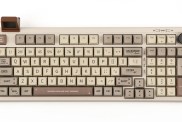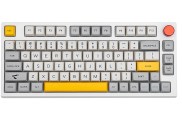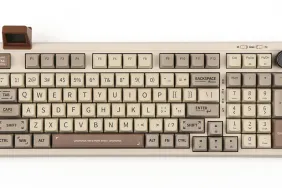A great disturbance.
For a franchise with "war" built into its very name, the dearth of quality Star Wars strategy games is bizarre. Everything is already in place – infantry, vehicles, heroes, buildings – but it’s been waiting for a solid RTS foundation that has inexplicably never come along.
Until now. Star Wars: Empire at War is an ambitious real-time strategy/galactic conquest hybrid. It may not do strategy as well as Dawn of War, conquest as well as Civilization IV or either as well as Rome: Total War, but it presents an interesting interplay between both schemes for a game that is strong in both the light and dark sides of the force.
[image1]Empire at War begins after the tragic end of The Revenge of the Sith and plays right up to the destruction of the original Death Star at the end of A New Hope. Two scripted single-player campaigns, one Rebel and one Empire, unfold the tale with a minimum of dramatic flair. Instead, the developers went for efficiency and utility. There are no gigantic cut-scenes or annoying movie clips, just simple, small holographic transmissions from your leaders (usually Mon Mothma or Darth Vader) that provide contexts for your battles without retelling a story you already know. Way to not overuse the force, LucasArts.
Where the main campaigns in linear games often feel like guided tours through movie sets, those in Empire at War feel more like cruises – you have several plotted destinations, but you’re also free to roam a bit. When a campaign begins, you’ll gaze down on a map of the galaxy with only a few planets in play. Some are under your control, some under your enemy’s, and some are open for conquest, while the rest are grayed out and inaccessible until you further the plot.
However, this isn’t accomplished by building lots of guard towers and moisture farms because you don’t build typical bases in Empire at War. Planets provide the only resource – money -on a daily basis, which is used to build structures on planets or in their orbits that will pump out units or provide defensive measures. These units are then used to protect your holdings or capture those of the enemy.
This is fine for the Empire, but it seems out of character for the rebellion. The movie conflicts seemed more like a game of cat and mouse, with the rebels working behind the scenes to undermine the Empire instead of just straight up attacking with full force. The rebellion differs slightly in that it uses R2D2 and C3PO to steal new technology from the Empire instead of developing it at a research facility, but that’s about the only difference.
At least the interface is nice and simple. Selecting planets, building units, and moving them from planet to planet is as simple as clicking and dragging, while a double-click can give you a closer look at any planet in the galaxy. Even with such a sensible system, managing an entire galaxy can be very hectic. Fortunately, you can slow down or speed up time as you see fit from the options menu.
[image2]As you progress along plotted planets, you and your foe gain access to new technology at a pace meant to keep the battles interesting and challenging until the end of the Death Star. But before this planet-sized mode can focus its energies on your entire weekend, a rogue squadron of bad A.I., weak unit balance, and a lack of compelling differences between the factions bring this cruiser to a halt.
Nowhere is this more apparent than in the game’s space battles. To assault a planet, you have to first send a fleet of ships into its orbit to blow up any enemy fleets or space stations. There are all sorts of different kinds of ships, but they pretty much fall into one of three categories: ships that take punishment, ships that dish out punishment from far away, and ships that seem to die immediately upon entering battle. If you have enough of the first two categories, you can win any battle.
The idea in space is to marshal a force so potent, it will kill off any attacking enemy ships before they have a chance to kill a single one of yours. This is critical, because you can’t produce units during battles. Instead, you bring as many ships as you want to a conflict, although the game imposes a unit cap of twenty. Whatever isn’t in the fight is considered a reinforcement and can be called in should any of your ships be destroyed. So, if you bring a fleet of fifty vessels to a fight, the game will create a somewhat random twenty-unit fleet from that and put it on the field. It’s annoying that it makes this decision for you, because it’s almost impossible to control which ships arrive on the battlefield in what order. You can’t swap units out, either, so if you really want a ship to enter a full battle, you’ll have to sacrifice something first. The force is weak with this idea.
Once you clean a planet’s orbit of enemy refuse, you can send an army down to the surface to finish the job. These battles are more interesting than the space variety, but they’re also much easier. Land battles usually begin with a unit cap of three. If you capture command points on the map, you can push this number up to ten, although you’ll never need to. Even though the CPU has the same limitations on its reinforcements as you do, it always sends its best, most expensive units after you first. The key to winning, then, is to kill the enemy’s first wave without losing anything. Once this is done you can relax and pick apart the rest of their forces with zero risk.
Like space battles, it’s difficult to control which units will begin a battle and it’s impossible to swap them out. This can be a huge pain, because only infantry can capture command points. If all three of your units are tank units, one of them will have to completely die (that’s a lot of money lost) before you can call down some infantry to capture something. Retarded this is.
Taken piece by piece, Empire at War doesn’t come off great. However, the real key to the game’s success lies in the persistence of units and structures. For example, any structure built on the surface of a planet will be present and destructible during a land battle. If you attack a planet and have bombers in orbit, you’ll be able to call down bombing runs on tough targets every couple of minutes. Cannons built on planet surfaces can fire into space, giving one side an advantage in space battles. All units in all battles carry over, so nothing is truly expendable since it might come in handy later. This really unifies the game, making every battle feel like part of a bigger war.
[image3]Aside from the great big campaign, the game offers eight galactic conquest campaigns and skirmishes. The former are mini-campaigns with specific objectives, such as defeating the enemy forces in a small range of planets within a set time limit. Skirmishes, on the other hand, are land battles where each side gets a base, some buildings and some cash. Your skirmish options are oddly limited. You don’t get to decide which buildings you start with or where they’re placed; you just make troops and send them against your enemy. There’s literally nothing to it.
The three-pronged approach to the gameplay, unfortunately, doesn’t carry over to the online play. Conquest games are simply too long and involved for normal online battles and the skirmishes and space battles are way too limited. The best way to experience this game is to play a big Risk-like conquest battle with a friend, saving your progress after long sessions. Short of that, it’s a game best experienced offline.
Regardless, it looks good. The space map where you do all your managing is clean and clear, with enemy routes becoming visible if you capture a point deep enough within their territory. The explosions look fine and the units are all adequate, though there isn’t a great deal of pizzazz. The only thing that comes close is the cinematic camera mode, but it makes controlling your forces nearly impossible.
Like a million games before it, Empire at War benefits from the wonderful Star Wars score and sound effects. It lacks authentic voice-overs, which takes a little of the fun out of commanding the Emperor around, but overall the game sounds just like Star Wars.
And it plays just like you might expect, doing all the usual things wrong but doing some very unusual things right. Its conquest content is thin and its RTS content is rudimentary, but the interplay between all these elements makes for an extremely immersive and convincing experience. Though not a particularly precious droid, this may actually be the Star Wars game you’re looking for.
-
Open galactic conquest
-
Good interface
-
Cool interplay between features
-
Limited space and land battles
-
Predictable AI
-
Not enough options











